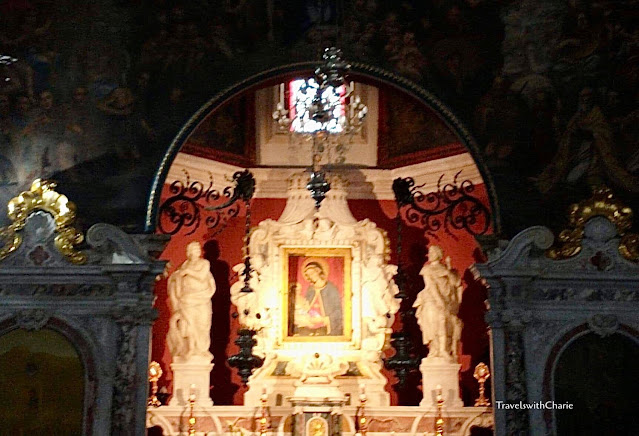Ceiling of Our Lady of the Rocks Church
Gospa od Skrpjela or Our Lady of the Rocks island is an artificial islet on Kotor Bay. Local lore tells the story of two fishermen who found an icon of the Madonna and Child on a rock in the bay and vowed to build a church where they had found it. From 1452 onward, seamen from Perast and Kotor brought large stones to the site to build up the islet. Today, the tradition of bringing stones to the island continues with the fašinada which is celebrated annually at sunset on July 22.
A Roman Catholic chapel was built on the islet in 1630. The church we see today is from 1722.
Mary on her deathbed
Many frescoes in the Church were painted by Tripo Kokolja, an artist from Perast.Notice the silver votive tablets that were offered by sailors to the Virgin Mary for a safe journey. Hundreds of these votives adorn the church.
There is a museum adjacent to the Church with artefacts related to the history of Perast. The entrance fee is €2.
View of the Church from the rear
Gift shop on the island
The Navigation light
It rained all day during my visit and not good at all for taking pictures. Kotor Bay (Boka) is surrounded by towering mountains providing a dramatic background for the bay. I wish I could go back on a sunny day to fully appreciate this magical place.
Sveti Djordje or The Island of the Dead Captains
Sveti Djordje or St. George Island is a natural island and home to the Benedictine Monastery. Local sea captains were buried here in the 18th century, hence the tag, “island of the dead”. The island is closed to visitors. This image was taken from Our Lady of the Rocks islet.How to get to Our Lady of the Rocks Island
Perast
There are many small boats from Perast harbor that take visitors to the island for €10 roundtrip (price in April 2022). It takes about 10 minutes to reach the island from Perast. If you arrive by car, there are parking lots by the waterfront.*****
Images by TravelswithCharie









